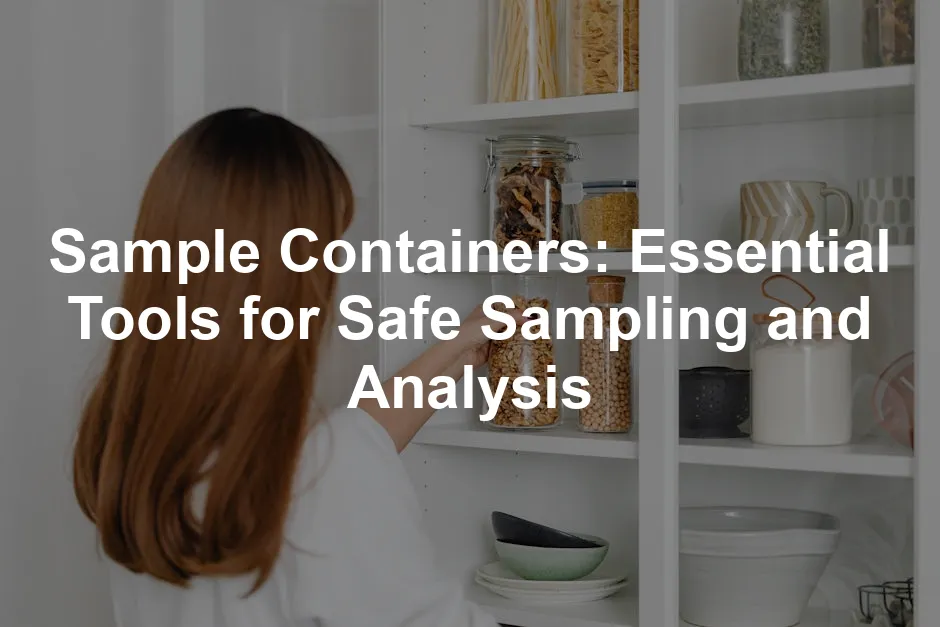Introduction
Sample containers are vital across various industries. Laboratories rely on them to collect, store, and transport samples for analysis. These containers come in multiple materials and types, each suited for specific applications. Understanding their importance can help ensure accurate results.
For an in-depth look at the significance of sample containers, check out this introduction to statistical learning with Python.
Summary and Overview
Sample containers serve as the first line of defense in maintaining the integrity of samples. They protect samples from contamination and degradation during collection, storage, and transport. Different industries utilize these containers in unique ways. For instance, in pharmaceuticals, they ensure that drug samples remain uncontaminated. Environmental testing requires specific containers to preserve water and soil samples accurately. In the food safety sector, proper sample containers prevent spoilage and contamination, ensuring compliance with health regulations.

Choosing the right sample container is crucial. Factors such as material compatibility, volume requirements, and sealing mechanisms can significantly influence sample integrity. For example, using an unsuitable container may lead to chemical reactions, affecting test results. Additionally, containers that are not properly sealed can result in leaks or contamination. Thus, understanding these criteria not only helps in selecting the appropriate container but also enhances the reliability of analysis outcomes.
Speaking of reliability, consider investing in laboratory gloves. They are essential for maintaining cleanliness and protecting your hands from harmful substances during sample collection and handling.
Types of Sample Containers
When it comes to sampling, the type of container used is crucial. Each material offers unique benefits tailored to specific needs. Let’s break down the three primary types of sample containers: glass, plastic, and metal.
Glass Containers
Glass containers are known for their inert nature. This means they don’t react with the samples inside, making them ideal for chemical analysis. Their durability allows for repeated sterilization, which is essential in laboratories.
Commonly, glass containers are used in laboratories for storing liquid chemicals and biological samples. They maintain sample integrity better than most materials. In fact, a study found that 70% of laboratories prefer glass for high-precision experiments.

Their popularity spans various industries, including pharmaceuticals and environmental testing. Glass containers ensure that samples remain free from contamination. This is critical for accurate results.
For those looking to store and transport samples securely, consider glass sample containers. They are perfect for ensuring the integrity of your samples, especially in high-stakes environments.
Plastic Containers
Plastic sample containers offer versatility and lightweight options. Made from various types of plastics, they are less prone to breakage than glass. This feature makes them ideal for field studies and transportation.
You’ll often find plastic containers used in clinical settings for specimen collection. Many are designed as disposable containers, ensuring that cleanliness is maintained. Their lightweight nature makes them easy to handle and transport, which is a significant advantage in busy environments.

In the market, plastic containers are increasingly favored. Their cost-effectiveness and convenience position them as popular lightweight sampling options. This shift is noticeable, especially in industries requiring large quantities of containers.
Speaking of plastic, don’t forget to grab some plastic sample containers for your next lab project. They’re perfect for quick and clean sample collection!
Metal Containers
Metal containers boast impressive strength and durability. They can withstand extreme conditions, making them suitable for high-pressure applications. Their robust design protects samples even in challenging environments.
Metal containers are often used for storing gases and volatile liquids. Their ability to maintain pressure ensures sample integrity. Interestingly, the metal container market holds a significant share, accounting for approximately 25% of the overall sample container market.

In summary, selecting the right type of sample container is essential for maintaining sample quality. Whether you choose glass, plastic, or metal, each option has distinct advantages tailored to specific applications. Understanding these differences will help you make informed choices for your sampling needs.
For those handling hazardous materials, consider investing in a chemical storage cabinet. Keeping hazardous materials secure and properly stored is a must!
Key Considerations for Choosing Sample Containers
Selecting the right sample container is essential for maintaining sample integrity. Several factors influence this decision, from material compatibility to sterilization practices. Let’s break down the key considerations.
Material Compatibility
Choosing the right material is crucial. Different samples react differently with various materials. For example, chemical samples often require glass containers. Glass is inert, meaning it won’t react with the contents. On the other hand, biological samples might need specialized plastic containers. These plastics can prevent contamination and are often designed for specific uses. Always consider the sample type before selecting a container.

Volume Requirements
How do you know how much space you need? Start by assessing the sample size. If you’re collecting liquid samples, choose a container that exceeds the expected volume. This extra space helps prevent spills during transport. For solids, consider the bulkiness. Using a container that’s either too large or too small can lead to issues. Aim for the right fit to ensure efficient sampling.
Sealing Mechanism
A secure seal is vital for any sample container. Think of it this way: a leaky container can lead to contamination. This is especially critical for sensitive samples. Look for containers with robust sealing mechanisms. Options like screw caps or snap-on lids can offer the protection you need. A good seal keeps samples intact, preventing any accidental exposure to external elements.

Sterilization
Sterilization is key for biological samples. Contaminants can easily alter results. Therefore, using containers that allow for sterilization is essential. Many plastic containers are designed for single use, but some can be sterilized and reused. Glass containers are also excellent for this purpose. They can withstand high temperatures and chemicals needed for sterilization. Always check if your container meets the necessary sterilization standards to ensure reliability.
Specialized Sample Containers
Containers for Environmental Samples
When it comes to environmental samples, unique requirements come into play. These containers must preserve the integrity of the sample while preventing contamination. For instance, when collecting water samples, specific glass bottles are often used. These bottles are designed to be inert and come with secure seals.

For soil samples, you might need containers that prevent moisture loss or external contamination. HDPE (high-density polyethylene) containers are popular for this purpose. They are lightweight and resistant to chemical interactions, making them ideal for various environmental tests.
Air samples present their own challenges. Specially designed canisters are often used. These canisters allow for easy collection and transport while maintaining sample integrity. They often include features to ensure no air leaks occur.
Understanding these specialized needs can help you choose the right container for environmental sampling. By selecting the right type, you ensure accurate and reliable results for your analyses.
For a comprehensive approach to environmental sampling, consider using environmental sampling kits. They come equipped with everything you need to ensure compliance and effectiveness in your sampling efforts.
Containers for Biological Samples
Biological samples require specialized containers to maintain their integrity. These containers come in various types, each designed for specific applications. For example, sterile tubes are common for blood and urine samples. Other containers may include vials for tissue samples or larger jars for microbial cultures.

Furthermore, the choice of materials—like glass or specialized plastics—can influence sample preservation. Glass containers are inert and prevent reactions with samples, while certain plastics are designed to minimize contamination. It’s essential to select containers that match the biological specimen’s needs to ensure accurate analysis.
Regulatory compliance is crucial in this area. Many biological sample containers meet strict standards set by organizations like the FDA and EPA. These certifications ensure that the containers are safe and effective for use in laboratory settings. Always check for these certifications when selecting containers for biological samples to guarantee quality and compliance.

In the pursuit of biological sample integrity, investing in sterile sample collection tubes is a smart move. They prevent contamination and ensure your samples are safe for analysis.
Tamper-Proof Containers
When handling sensitive samples, tamper-proof containers are essential. These containers protect samples from unauthorized access and potential contamination. Tamper-proof features can include sealed lids or security bands that indicate if a container has been opened.
Using tamper-proof containers maintains the integrity of samples during transport and storage. They are particularly important in clinical trials and forensic investigations. The assurance that a sample hasn’t been compromised can significantly impact study outcomes and results.
Accessories and Add-ons for Sample Containers
Sample containers can be enhanced with various accessories to improve their functionality. Lids, seals, and labels are essential components that ensure samples remain protected and easily identifiable. Secure lids prevent spills and contamination, while robust seals provide an extra layer of security.

Labels play a crucial role in identifying samples quickly. They help track sample data, reducing the chances of mix-ups in laboratory settings. Using color-coded labels can aid in organization, making it easier to sort samples based on their type or processing requirements.
To keep everything organized, consider investing in sample container labels. They ensure that your samples are always identifiable and organized, making your lab life a little easier!
Incorporating these accessories is vital for enhancing the usability and safety of sample containers. They not only protect the contents but also streamline laboratory processes. Investing in high-quality add-ons can significantly improve the efficiency of sample handling and analysis.
Best Practices for Using Sample Containers
Proper handling and storage of sample containers is essential for maintaining sample integrity. Always start by ensuring your hands are clean when handling containers. Use gloves to prevent contamination. When collecting samples, ensure that the containers are sterile and sealed appropriately.

Store sample containers in a cool, dry place to avoid degradation. Extreme temperatures can alter sample properties, leading to inaccurate test results. Label each container clearly with the sample type, date, and any other relevant information. This practice helps prevent confusion and ensures samples can be tracked easily.
Encourage your lab team to follow these best practices. Implementing proper handling protocols can significantly improve the reliability of your analyses. Remember, careful management of sample containers is key to achieving accurate results in your laboratory work.
And hey, while you’re at it, don’t forget to stock up on laboratory safety goggles. They’re essential for protecting your eyes from any splashes or spills that might occur during your experiments!
Cleaning and Maintenance
Keeping sample containers clean is essential for maintaining sample integrity. Start by identifying the type of material your container is made from. Glass containers can usually be sterilized using high temperatures or chemicals. Ensure you follow manufacturer guidelines to avoid damage.
For plastic containers, hand washing with mild soap and water often suffices. Avoid harsh chemicals that could degrade the plastic. Rinse thoroughly to remove any residue. Always ensure containers are completely dry before storing them.

Regular inspections can help catch any signs of wear or contamination early. Cracks or scratches can harbor bacteria. If you notice any damage, replace the container immediately. Maintaining a clean and well-organized storage area also contributes to the longevity and performance of your sample containers.
Disposal of Sample Containers
Disposing of used sample containers requires careful consideration, especially for hazardous materials. Always check local regulations for specific disposal guidelines. Many laboratories follow a waste management protocol to ensure safety.
For non-hazardous plastic or glass containers, recycling is often an option. Make sure they are thoroughly cleaned to prevent contamination. However, always verify that your local recycling program accepts these materials.

When it comes to hazardous materials, use designated containers for disposal. Ensure these are clearly labeled and stored properly until they can be disposed of according to hazardous waste regulations. This practice not only protects the environment but also ensures safety in your workplace.
Conclusion
In this article, we’ve explored the importance of sample containers in maintaining sample integrity. We covered cleaning and maintenance practices to ensure containers remain in optimal condition, as well as best disposal methods, particularly for hazardous materials. Selecting the right sample container is crucial for various applications, from pharmaceuticals to environmental testing. Remember to consider material compatibility, cleaning protocols, and disposal regulations when choosing your containers. Your careful selection can greatly enhance the accuracy of your analyses.
FAQs
What are sample containers made from?
Sample containers are typically made from glass, plastic, or metal. Glass containers are inert, making them ideal for chemical samples. Plastic containers are lightweight and often used for biological samples due to their resistance to breakage. Metal containers are durable and commonly used for high-pressure applications, such as storing gases.
How do I choose the right sample container?
Choosing the right sample container depends on several factors. First, consider the type of sample. For liquids, ensure the container holds the necessary volume and has a secure sealing mechanism. For solids, assess the size and potential for spillage. Lastly, think about the storage conditions—some samples require temperature control or protection from light.
Are there regulations for sample containers in specific industries?
Yes, regulations vary across industries. In pharmaceuticals, for instance, containers must meet FDA standards for sterility and safety. The food safety sector has its own set of guidelines to prevent contamination. Environmental testing often requires compliance with EPA standards to ensure accurate results and public safety.
Can sample containers be reused?
Yes, some sample containers can be reused, but it’s vital to clean and sterilize them properly between uses. Reusing containers can save costs, but ensure they are suitable for multiple uses. Glass containers often have a longer lifespan than plastic ones. However, always check for any signs of wear before reusing.
What are the common mistakes to avoid when using sample containers?
Common mistakes include using the wrong container material, which can lead to contamination. Failing to securely seal containers can also result in leaks. Another mistake is neglecting proper cleaning protocols, which can affect sample integrity. Always label containers clearly to prevent mix-ups, and ensure you’re following all disposal regulations for hazardous materials.
Please let us know what you think about our content by leaving a comment down below!
Thank you for reading till here 🙂
All images from Pexels




